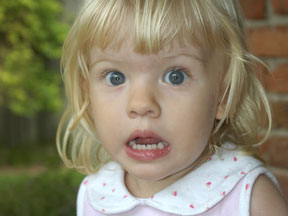The big day your princess has dreamed about is here. But the first door she knocks on is answered by a cackling witch, and the fun of Halloween dress-up ends for your little Snow White faster than you can say, “Don’t bite that apple!”
 A University of Alabama at Birmingham child psychologist says it is difficult to avoid the things that create nightmares this time of year, and the best thing you can do is to prepare a young child for tombstones in the neighbor’s yard and ghoulish costumes and spooky decorations in the store aisles and daily mail.
A University of Alabama at Birmingham child psychologist says it is difficult to avoid the things that create nightmares this time of year, and the best thing you can do is to prepare a young child for tombstones in the neighbor’s yard and ghoulish costumes and spooky decorations in the store aisles and daily mail.
“Throwing a child who doesn't swim into the pool is never a good idea,” says child-adolescent psychologist Vivian Friedman, Ph.D., professor in the UAB Department of Psychiatry and Behavioral Neurobiology. “Forcing a child into a situation he fears is likely to make it worse.”
Your child will eventually understand the difference between real and imaginary, possible and impossible or fear and actual danger. “A lack of understanding is the root of most irrational fears and superstitions,” says Friedman. “A 2-year-old fears going down the bathtub drain because he doesn’t know that he is too big to fit down a small hole.”
Friedman recommends several ways to make fears more manageable:
- Protect children from excessive exposure to things that frighten them.
- Don’t ridicule.
- Deal with the specific fear.
- Give them words with which to cope.
Keep the coping words positive. “I am strong.” “I am brave.” “Fear does not control me.” These will be words your child will use to self-talk when they are scared.
Parents, in turn, should not be scared of a child’s fear. “Unless the child's fear is in the pathological range, he is unlikely to be affected by costumes in a store,” says Friedman. “All but the most severely mentally ill children will outgrow Halloween fear.”